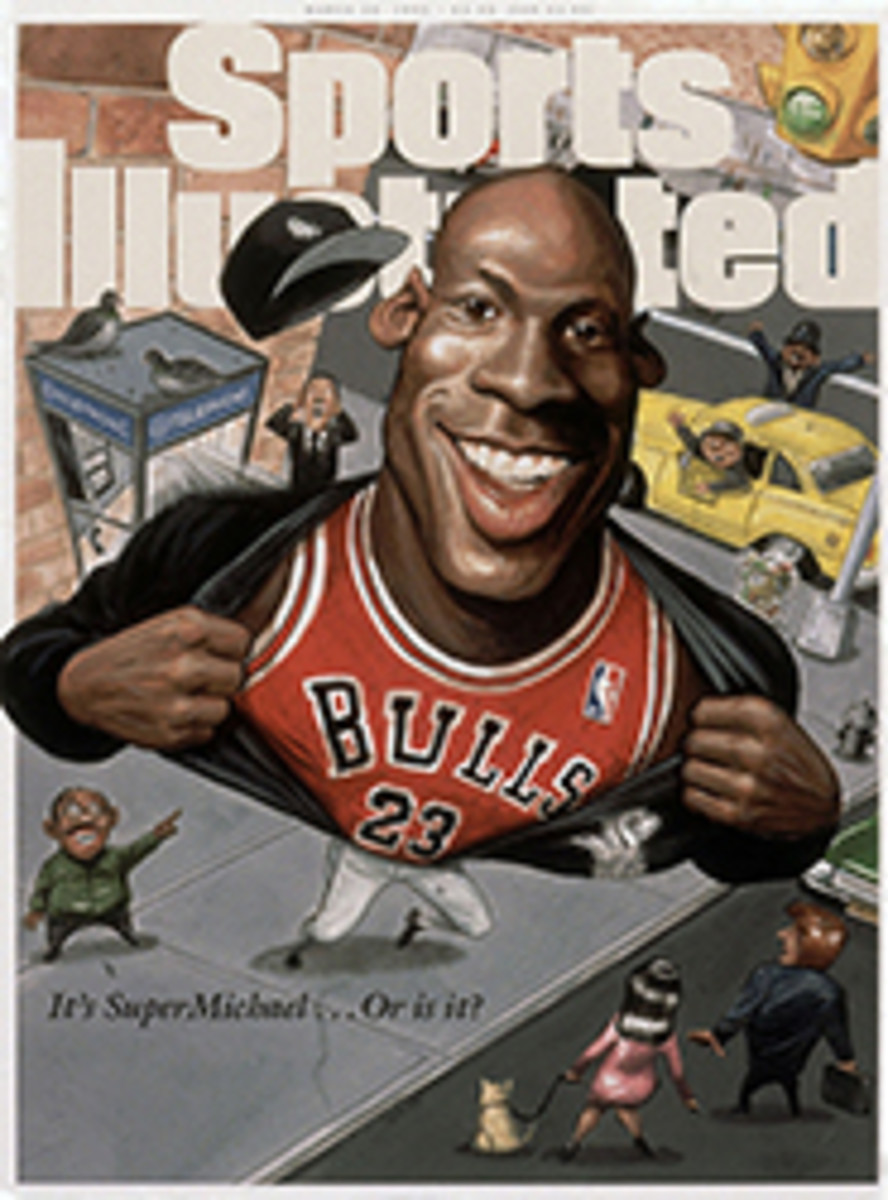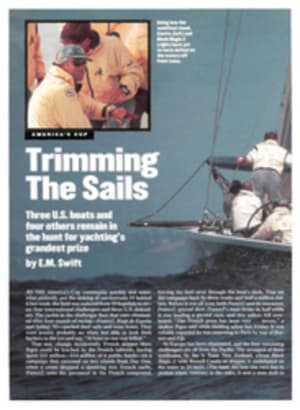
THE DOPE ON LONGBOARDS IN 19TH-CENTURY BIG-SKI RACING, NOW ENJOYING A REVIVAL, IT WAS ALL IN THE WAX
``Do you realize how difficult it is to find these?'' asks Craig
Beck, holding up a pair of thin white candles and pacing back and
forth in his cluttered ski-making workshop near Lake Tahoe, Calif.
Beck, 49, is the founder of the National Longboard Association, a
group of skiers dedicated to -- no, make that obsessed with --
re-creating a style of ski racing that flourished in northern
California mining camps in the late-19th and early-20th
centuries. And for Beck, no aspect of making his skis authentic is
too trivial to overlook, even if it means hunting down
100-year-old candles made from whale sperm.
The skis Beck makes, enormous wooden slats known as longboards,
are fashioned from the same materials as their 19th-century
forerunners and cut to the same specifications with antique tools.
During the National Longboard Association's races, held in
California's Sierra Nevada mountain range from January through
April, participants dress in period costumes. And when it comes to
preparing the skis for racing, Beck insists that his waxes be made
strictly according to traditional recipes.
These recipes, which Beck discovered while researching the history
of longboard racing, read like something from the Salem witch
trials. The concoctions -- called dope by the old racers -- had
names like Skedaddle and Breakneck and Greased Lightning. They
included such ingredients as glycerin, camphor oil, pine pitch,
balsam fir, bristlecone drops and, of course, sperm.
``I had to read and read and read to find out that sperm meant
whale sperm, also known as spermaceti,'' says Beck, explaining
that the substance is a waxy material found in the heads of sperm
whales and that it was once used in the production of cosmetics
and candles. ``When I started asking around and trying to buy some
sperm I was told, `You can't get that -- whales are an endangered
species, and spermaceti hasn't been sold since the 1800s.' ''
Beck wasn't deterred. He traveled to Hawaii, where whaling was
practiced in the 19th century, and visited old fishing villages
trying to track down any remaining spermaceti. ``In the basement
of a thrift shop in a tiny town on Maui, I found four spermaceti
candles,'' says Beck. ``On the box it says they were made in
1894.'' Eventually Beck gathered all the other necessary waxmaking
materials and was able to make his genuine longboard racing dope.
Beck, who has lived in the Lake Tahoe area since the age of 14,
never seems to do anything halfway. His father, Don, was an Air
Force test pilot and champion biplane racer, and from him Craig
inherited a passion for all things fast-moving. Sitting in Craig's
garage is a flaming red 1966 Shelby Cobra that, he says proudly,
``can easily go over 200 miles per hour.'' Beck is an experienced
pilot of power planes, sailplanes and ultralights, as well as an
expert hang glider, speed skier and extreme skier.
Married with three children ranging in age from 12 to 24, Beck
makes his living as a general contractor and sports-action
filmmaker, specializing in skiing and hang-gliding productions. He
became intrigued by longboard racing in the early '80s while
researching a screenplay that he was writing about John (Snowshoe)
Thompson. Thompson was a legendary mid-19th-century postman who
delivered mail to remote mining towns in the Sierra Nevada by
climbing over mountain passes while wearing long wooden skis that
he called Norwegian snowshoes. As Thompson's fame spread -- during
severe winters he was the northern Sierra's only link to the
outside world -- so did the use of longboards. By the 1860s,
longboard racing (sometimes also called snowshoe racing) had
become the mining communities' main winter recreation.
The miners were a rough-and-tumble lot, and the races reflected
it. They were flat-out speed events. Racers, several at a time,
would line up at the top of a hill and head straight to the bottom
without making so much as a single turn. According to newspaper
accounts, winners would sometimes reach speeds of more than 80
mph.
The top racers were usually those whose skis had the slipperiest
wax, and the winning team's chief waxmaker -- called the
dopemaster -- often became more famous than the champions
themselves. Formulas for fast dopes were closely guarded secrets.
For nearly 40 years, when racers from nearby towns competed
against each other, crowds gathered and large sums of money put up
by the local ski clubs were awarded to the winners. Rivalries
between some towns were so intense that battles in the newspaper
editorial pages -- each town's paper telling its readers just how
badly it would whip its opponents -- would begin weeks before the
actual contest. But in the early 1900s, as the mines began
shutting down and the Sierra's population started shrinking, no
amount of dedication could save longboard competition. The last
major race was held in 1911.
Intrigued by the speed and danger of longboard racing, Beck spent
years researching the sport. He ferreted out dope recipes, found
old newspaper clippings and family diaries, rummaged through
former mining towns and interviewed historians. Finally, in 1993,
he decided to build his own pair of longboards. ``I looked at
hundreds of pieces of wood,'' says Beck, ``before I found two
perfect planks of vertical-grain Douglas fir.''
Beck next constructed a ski-tip bender, copying the design from a
picture he found in a book. He used a 150-year-old ski groover to
cut a thin channel in the bottom of each ski, which reduced
friction. And, of course, his dope was as authentic as it comes.
After a month of labor, the first set of longboards to be made in
85 years were ready for use.
Meanwhile, in Plumas County, about 40 miles northwest of Beck's
home, a group of ski-history buffs had begun their own longboard
revival in 1991, staging demonstrations at one of the original
longboard racing hills, in Johnsville (now the Plumas-Eureka Ski
Bowl), with equipment borrowed from a local museum. When Beck
proposed a race series between a team of his from the Lake Tahoe
area -- which he named the Sierra Lightning -- and the Plumas Ski
Club, the Plumas skiers immediately accepted, going so far as to
place a few jeering messages in the local paper.
Members of the two teams built their own skis (the ones in the
museum were deemed too valuable to use for racing) and concocted
various dopes. The association held four racing events last
winter; five were scheduled for this season. At the races men ski
wearing cowboy boots and wool pants; the women, long dresses and
high-heel lace-ups. The longboards, which are between 10 and 16
feet in length, are attached to the racers' feet by leather
straps. Competitors line up at the start, two or three to a heat,
each holding a single wooden pole.
For the starting signal, a hammer is pounded against an old
circular saw blade. After a few furious pushes with the pole, each
racer tucks it underneath his or her arm, dips into a
longboarder's crouch -- similar to that of a baseball catcher
waiting for a pitch -- and speeds straight down the hill. Or
sometimes not so straight. ``You don't control longboards,'' says
one racer. ``They control you.'' If the boards drift to one side
or clatter against one another, the skier drifts and clatters with
them.
Not surprisingly, wipeouts are common. Those who do make it down
the roughly 1,500-foot course -- it takes about 15 or 20 seconds
-- stop themselves by jamming the pole between their legs and
sitting on it, sending a plume of snow into the air and slowly
bringing the skis to a halt. The winner of a heat hikes back up
the hill for another round; losers are done for the day.
Last winter Beck and his teammates, using the whale-sperm dope,
ruled the races. Sierra Lightning members won all four meets, and
Beck was declared national champion. This season, however, things
began differently. The Plumas Club dopemaster, Scott Lawson, 38,
who is also one of the Plumas County Museum's curators, has
evidently discovered a superior dope. Before this winter's first
competition, held on Jan. 29 at the Plumas-Eureka Ski Bowl, Lawson
spent hours waxing his team's skis. He kept his dope with him at
all times, carrying it in a padlocked wooden box.
The race was a blowout. The Plumas Club swept the top three spots
in both the men's and the women's events. After the race a few
members of the Lightning, wondering what had caused their change
of fortune, asked Lawson what ingredients he had used in his wax.
Lawson flashed a sly grin. ``I'll never tell,'' he said, squinting
with delight and hugging his dope box.
But in the second race, which was held on Feb 26, the Lightning
exacted revenge: the men took first through eighth place; the
women, first and second. Said Beck after the race, ``We're not
telling our secrets either.''
Michael Finkel, an avid skier, writes often on skiing and other
winter sports.
COLOR PHOTO:PHOTOGRAPHS BY HANK DEVREBeck (with son David) may show you his homemade ski dope, but don't bother to ask what's in it. [Craig and David Beck standing among longboards]COLOR PHOTO:PHOTOGRAPHS BY HANK DEVRE At the season opener in January, Mark Rivard stepped into a pair of Beck's longboards and let 'er rip. [Mark Rivard skiing down mountain]

